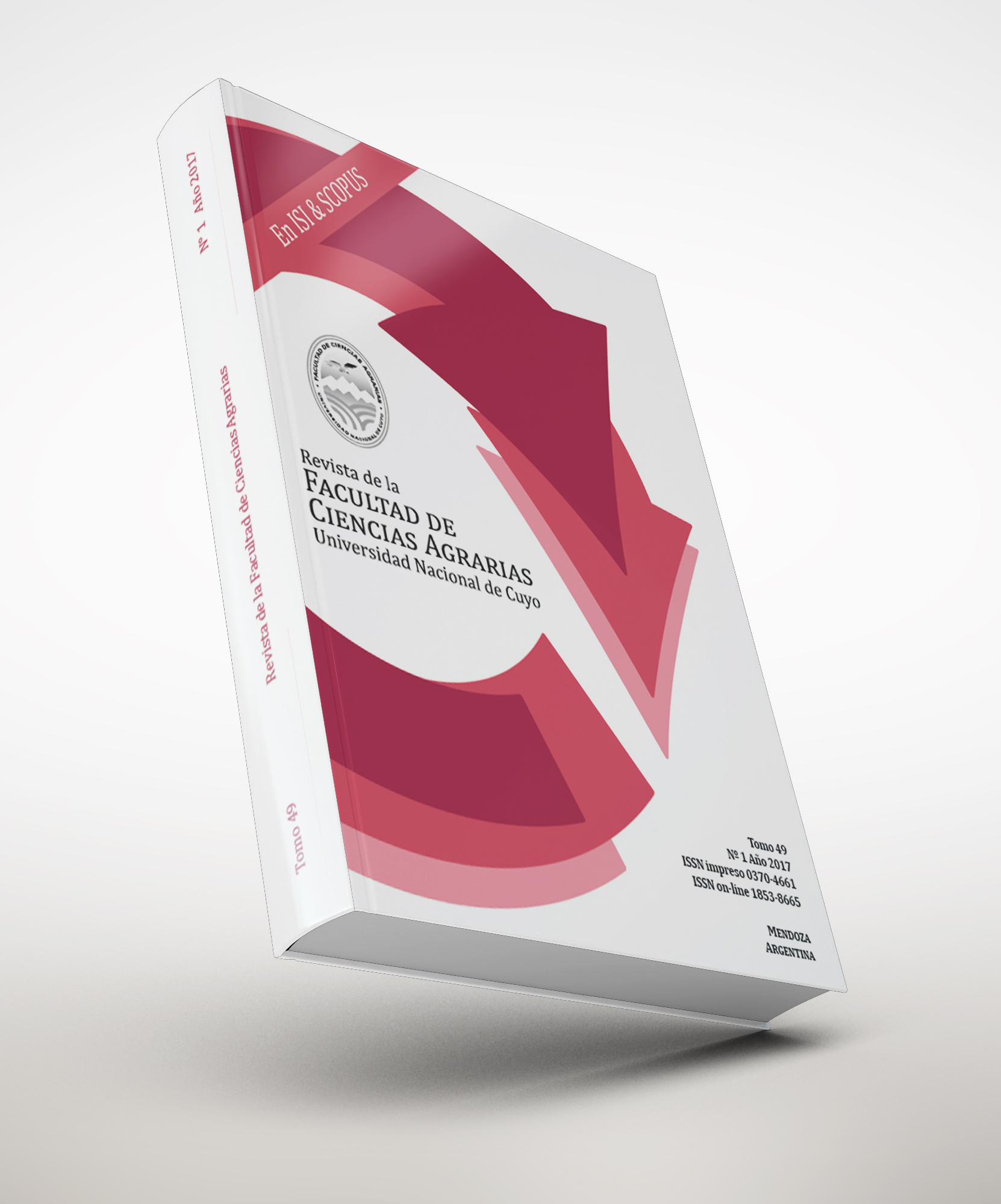Ver ítem
- xmlui.general.dspace_homeCentros Regionales y EEAsCentro Regional CórdobaEEA ManfrediArtículos científicosxmlui.ArtifactBrowser.ItemViewer.trail
- Inicio
- Centros Regionales y EEAs
- Centro Regional Córdoba
- EEA Manfredi
- Artículos científicos
- Ver ítem
Impacto de mancha ojo de rana (Cercospora sojina k. Hara) sobre rendimiento y componentes industriales del grano de soja: aceite y proteína = Impact of frogeye leaf spot (Cercospora sojina k. Hara) on yield and soybean seed industrial components: oil and protein
Resumen
La mezcla de fungicidas estrobilurina y triazol (E+T) se aplicó a 2 cultivares contrastantes en susceptibilidad a mancha ojo de rana (MOR) (DM3700 y DM3810) en los estadíos R3 o R3+R5; se incluyeron además 2 controles: enfermo y sano. Se avaluó incidencia y severidad de MOR, rendimiento, número de granos (NG), peso de granos (PG), aceite y proteína del grano. Se observaron distintos niveles de severidad entre tratamientos de DM3700 y ausencia de MOR en
[ver mas...]
La mezcla de fungicidas estrobilurina y triazol (E+T) se aplicó a 2 cultivares contrastantes en susceptibilidad a mancha ojo de rana (MOR) (DM3700 y DM3810) en los estadíos R3 o R3+R5; se incluyeron además 2 controles: enfermo y sano. Se avaluó incidencia y severidad de MOR, rendimiento, número de granos (NG), peso de granos (PG), aceite y proteína del grano. Se observaron distintos niveles de severidad entre tratamientos de DM3700 y ausencia de MOR en los tratamientos de DM3810. Se encontró correlación negativa entre severidad y rendimiento. En DM3700 los valores más elevados de severidad se correspondieron con rendimientos más bajos (2117 kg/ha). DM3810 exhibió rendimientos elevados y sin diferencias estadísticas entre tratamientos (3478 kg/ha). Aunque NG y PG disminuyeron en el testigo enfermo DM3700, las reducciones del NG fueron más pronunciadas. No hubo incrementos de rendimiento, NG y/o PG atribuidos a E+T en DM3810. La severidad máxima en el cultivar más susceptible no fue suficiente para disminuir significativamente aceite y proteína. MOR pudo ser controlada en el cultivar susceptible con una única aplicación de E+T en R3. El uso del cultivar resistente a MOR resultó efectivo para controlar la enfermedad y no manifestó beneficios adicionales en rendimiento debido a la aplicación de fungicidas. En este trabajo se concluyó que MOR no afectó la calidad industrial del grano.
[Cerrar]
The mixture of strobilurin and triazole
(S+T) was applied to 2 contrasting cultivars
in susceptibility to frogeye leaf spot (FLS)
(DM3700 y DM3810) at growth stages R3 or
R3+R5; untreated control and healthy control
were also included. Incidence and severity of
FLS, yield, grain number (NG), grain weight
(GW), grain oil and protein were evaluated.
Different levels of severity between DM3700
(susceptible) treatments, and absence of FLS in
DM3810
[ver mas...]
The mixture of strobilurin and triazole
(S+T) was applied to 2 contrasting cultivars
in susceptibility to frogeye leaf spot (FLS)
(DM3700 y DM3810) at growth stages R3 or
R3+R5; untreated control and healthy control
were also included. Incidence and severity of
FLS, yield, grain number (NG), grain weight
(GW), grain oil and protein were evaluated.
Different levels of severity between DM3700
(susceptible) treatments, and absence of FLS in
DM3810 (resistant) treatments were observed.
Negative correlation was found between severity
and yield. In DM3700 higher values of severity
corresponded to lower yields (2117 kg/ha).
DM3810 exhibited the higher yields without
statistical differences between treatments
(3478 kg/ha). Although NG and PG decreased
in the untreated control DM3700, NG reductions
were more pronounced. No increments of
yield, NG and/or PG were attributed to S+T in
DM3810. The maximum severity achieved by the
more susceptible cultivar was not sufficient to
significantly decrease oil and protein. FLS could be controlled on the susceptible cultivar with a
single application of S+T at R3. The use of the
resistant cv to FLS was effective in controlling
the disease, and showed no additional benefits
in yield due to fungicide application. It was
concluded that FLS did not affect the chemical
quality of the grain.
[Cerrar]

Autor
Gaido, Nicolás E.;
Gieco, Jorge Omar;
Carrera, Constanza Soledad;
Fuente
Revista de la Facultad de Ciencias Agrarias, Universidad Nacional de Cuyo 45 (2): 327-340. (2013)
Fecha
2013
Editorial
Facultad de Ciencias Agrarias, Universidad Nacional de Cuyo
ISSN
0370-4661
1853-8665 (Online)
1853-8665 (Online)
Formato
pdf
Tipo de documento
artículo
Palabras Claves
Derechos de acceso
Abierto
 Excepto donde se diga explicitamente, este item se publica bajo la siguiente descripción: Creative Commons Attribution-NonCommercial-ShareAlike 2.5 Unported (CC BY-NC-SA 2.5)
Excepto donde se diga explicitamente, este item se publica bajo la siguiente descripción: Creative Commons Attribution-NonCommercial-ShareAlike 2.5 Unported (CC BY-NC-SA 2.5)


